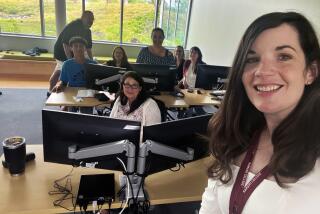Trail of Teeth : Forensic Dentist Is Key in Unlocking Mystery of Unknown Dead
BALTIMORE — It is a grisly discovery.
Children playing in the woods near Annapolis find a human skull. Searching nearby, police later find a jawbone and scattered teeth. But the rest of the skeleton is missing.
The state medical examiner puts in a call to Bernard A. Levy, associate professor of oral pathology at the University of Maryland and, at the time, the state’s only forensic dentist.
The bones, and a handful of loose teeth found nearby, are turned over to Levy, and he goes to work.
For most of the last 20 years, when law enforcement authorities in Maryland have needed help identifying a badly damaged or decomposed body, they have called on Bernie Levy.
A patient, soft-spoken, delicately built man, Levy would probably rather be fly-fishing or reading Sherlock Holmes. He is quick to admit that what he does for the medical examiner’s office is grim.
But he enjoys a good story. Especially a mystery.
“Granted, it’s morbid,” he said one recent afternoon in his tiny office at the university’s Dental School in Baltimore. “But it’s fascinating. It’s a fascination, A, with the morbidity, and, B, with solving a puzzle.”
With bones and teeth in hand, Levy sets about trying to match the loose teeth to the empty tooth sockets in the skull and the jawbone.
Some of the sockets are blunted and filled in, signs that the teeth were lost or extracted well before death. But others are empty and rimmed by clean, jagged bone, signs that the teeth fell out after death.
Sometimes well-meaning police officers try to re-insert the teeth they find scattered about the crime scene. Often, they get them wrong.
“Only a dentist will know that this is an upper and this is a lower,” Levy says. “A lot of times I’m a little unsure myself.”
Painstakingly, though, Levy draws his conclusions, and tooth by tooth, he begins to compile a detailed dental record for the unknown person.
In the heat and humidity of summer, it may take only six to eight weeks for the soft parts of a human body to be consumed and scattered by microbes, insects and small animals.
In less than a decade, the bones, too, may be gone. In a fire, everything can disappear in minutes. Except for the teeth.
“If you placed a body in a coffin, and it went into a crematorium, with fire and flames at 1,100 degrees . . . and afterward you had one of the descendants pour out the ashes, you know what they’d find?” Levy asked.
“No part of the body would be left except the teeth.”
The durability of teeth, plus the individuality of dental work, is why investigators turn to dental records to make positive identifications of otherwise unidentifiable human remains.
“There’s no great knowledge required, no phenomenal skill,” Levy said. “Only intense patience and concentration. There’s no room for a mistake.”
Levy can see right away that the skull from the woods in Annapolis enjoyed some “very expensive dentistry” in life.
There are several well-made gold crowns, the work of a meticulous and costly private practitioner. It was money well-spent. The dentist preserved every tooth.
So Levy concludes that the skull belonged to someone in an “upper socioeconomic bracket,” probably middle-aged.
“Up to 18 or 21, I can very accurately tell you the age,” he said. “After that, we’re dealing in broad guesses.”
In this case, there are signs of some periodontal disease--gum inflammation that causes the gums and underlying bones to recede. The person was getting “long in the tooth.”
“But the teeth aren’t old and worn out,” Levy added. It is probably an adult, between 40 and 50.
From the oval shape of the arch of the jaw, Levy concludes these are probably the remains of a Caucasian. Blacks’ jaws are generally more square, Asians’ more angular.
And, finally, from the thick, heavy structure of the bones, Levy decides this was probably a male.
The mystery skull now had a tentative identity and a detailed dental chart. Somewhere, in a dentist’s file drawer, there was a nearly identical chart waiting to be discovered.
Matching dental records to human remains is perhaps the most unpredictable part of forensic dentistry.
Normally, police have a good idea of who the victim was, and with the family’s help, they’re ready with the dental records. By comparing the records with the dental chart, photographs and X-rays he has assembled from the remains, Levy can often confirm a match in short order.
But it’s not always that easy.
Levy recalled the 1987 case of a Baltimore man who had been slain and left to decompose in the trunk of a car. Police thought they knew who it was, but “there were no fillings in his head,” Levy recalled. “He had never had any dental work. So how am I going to do an ID?”
“So I put the lower jaw together with the upper, and what I see is interesting,” he said. “He was very, very buck-toothed.”
He also had a small chip in the corner of his right front tooth.
Levy telephoned the parents of the missing man, in California, and asked them to send him any pictures they had. What he received were all smiling front views. Blow-ups of the photograph showed a chip, and a close match to the other teeth. But it was not enough for Levy to confirm the identification and stand by it if called to testify in court. He needed more.
He asked the man’s parents again for any side-view pictures. They said their son never liked to have side views taken, but they found a single newspaper clipping that showed him from the side.
“He was buck-toothed. That’s why he never liked to have side shots taken,” Levy says.
An enlargement of the photograph in the clipping was laid over a picture of the skull, blown up to the same scale. The match was perfect.
More to Read
Sign up for Essential California
The most important California stories and recommendations in your inbox every morning.
You may occasionally receive promotional content from the Los Angeles Times.










